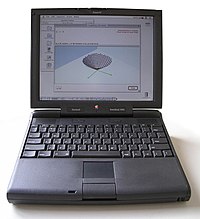PowerBook 3400c

Apple PowerBook 3400c/200
|
|
| Developer | Apple Computer |
|---|---|
| Type | Laptop |
| Release date | February 17, 1997 |
| Discontinued | November 7, 1997 |
| Operating system | Mac OS 7.6 |
| CPU | PowerPC 603e, 180–240 MHz |
| Predecessor | PowerBook 500 |
| Successor | PowerBook G3 |
The PowerBook 3400c is a laptop computer in the PowerBook line manufactured by Apple Computer from February to November 1997. It was, briefly, the swiftest laptop in the world. Using the PowerPC 603e processor running at speeds of up to 240 MHz, this PowerBook was the first to feature a PCI architecture,EDO memory, and a 64-bit wide, 40 MHz internal bus. It was also the first PowerBook to feature a PC card slot capable of being used as a zoomed video port. Like all Apple laptops since the PowerBook 500 series, it featured a built-in trackpad as the pointing device.
The PowerBook 3400c series was issued in three different models, distinguished primarily by their processor speed. The base model ran at 180 MHz, and the two higher end models ran at 200 MHz and 240 MHz. Thus, the different models were referred to as the 3400c/180, 3400c/200, and 3400c/240. The 3400c/180 model was usually sold with only a built-in modem and a floppy drive; all 3400c/200 and 3400c/240 machines came with a built-in modem/Ethernet combination port and hot-swappable 1.4 MB floppy disk and CD drives. The only other difference between them was the size of the hard drive, ranging from 1.3 to 3.0 GB depending on the model.
Prior to the PowerBook 3400c series, the names of PowerBooks reflected (among other things) the type of screen they had installed. For example, the PowerBook 1400cs had a passive matrix screen, and the 1400c an active matrix screen. Because all PowerBook 3400c computers came with the same 16-bit color, active matrix screen, the "c" designation at the end of the PowerBook 3400c name was somewhat superfluous, and is often dropped, even by Apple itself, for example in the user's manual. The internal code name used for the PowerBook 3400c during development was "Hooper", named so after one of the product design engineer's dog.
...
Wikipedia
